#Musique Volume I
Text
✯ music? date? both ; charles leclerc
a/n: based on a tiktok i saw earlier, by teilhard_ :)
summary: she listens to music when getting ready. he loves it. she sends him a note - he asks her out.
warnings: none.
── ☆⋆。𖦹°‧★
You were a major music lover.
Getting ready? Listen to music. Reading? Listen to music. Driving? Listen to music. Bored? You guessed it.
Everyone knew that about you - you were unbelievably passionate about music. Any type of music.
“Y/NNNN, can we hang out today? iʼm bored” said a text from your friend. Naturally, you agreed - why not? It was a Saturday night and you had no plans whatsoever.
Like always, you turned on your regular playlist, making sure the volume is suitable only for your ears to hear, not to disturb any of your neighbors. Unbeknownst to you, your next door neighbor could listen to every sound coming out of your speakers. He was a nice guy - you interacted a few times, little “hello”s and “how are you”s every time you would randomly bump into each other. Despite being famous worldwide, he was extremely humble.
He was also devilishly handsome. But you never actually admitted that.
As you swiftly moved around your apartment to grab little bits and bobs needed to get ready, occasionally humming or singing along with the music, Charles Leclerc was sitting in the apartment right next to yours, attempting to read.
If he was bothered by your music, he wouldn’t hesitate to tell you - but he wasnʼt. It gave his currently dull and dead apartment a lively feel to it. Plus, your music taste was unmatchable.
As you put on some final touches, you paused your music and turned off your speakers. You grabbed your purse, phone and keys and left your apartment, shutting your door with a soft thud.
It wasn’t the first time Charles heard your music - in fact, ever since he moved in, he’d be hearing various music genres at various times of the day. This almost seemed like his final straw; he wanted to get to know you more.
He didn’t know how to approach you - he didn’t have your number, your social media, not even an email. So he channeled his inner creativity and decided to talk to you in a special way.
The special way was by leaving you a note by your doorstep. Not very original, eh?
As you were out with your friend enjoying your night, Charles was tapping his pen on the desk trying to think of what to write. After a few long hours, Charles had written the perfect note and placed it by your doorstep, hoping to see a response in the morning.
You stumbled back into your apartment complex, trying not to make a noise. You werenʼt drunk, just tired, your body begging you to fall asleep. You paid little to no attention as to what you were stepping on as you approached your door, keys in hand. As you were about to walk in, something felt stiff underneath your shoes. Looking down, you saw a small cream envelope with your name written on it in fancy cursive writing.
You bent down to pick it up and walked inside your apartment, your eyes still on the envelope. What is this?
You sit down on your couch and carefully open the letter, not wanting to rip the envelope.
“Bonjour -
Je voulais juste dire que tu écoutes de la très bonne musique, jʼadore ça!
PS: écoute “This Charming Man” de The Smiths, tu devrais aimer...
- Charles (ton voisin, n°28)”
[ Hello -
I just wanted to say that you listen to really good music, I love it!
PS: listen to “This Charming Man” by The Smiths, you should like it...
- Charles (your neighbor, n°28) ]
You immediately smiled at the note, your heart bursting with pride. If someone compliments your music taste and recommends a song, they are immediately very dear to you.
You placed the note back into its envelope and got up to change and refresh. Youʼll make sure to write back - you just donʼt really know how.
The next day, the first thing Charles did when he got up was to check for a note. He didn’t find anything. Nothing.
He sighed and decided to get on with his day. He shouldnʼt have expected a lot, really. As he left his apartment, he checked for one last time - still, nothing.
Little did he know you were just writing his name on an envelope to place on his doorstep.
The day passed, both of you anxiously waiting for a reply from each other. When Charles finally came home and saw a pink envelope on his doorstep, he smiled so hard his cheeks must have been screaming. He grabbed the envelope and rushed inside, the smile never leaving his face.
“Bonjour!
Merci beaucoup! Cela signifie beaucoup. La chanson est incroyable, The Smiths ne déçoivent jamais.
PS: écoute de “Good Looking” de Suki Waterhouse :)
- Y/N”
[ Hello!
Thank you so much! It means a lot! The song is amazing, The Smiths never disappoint.
PS: listen to “Good Looking” by Suki Waterhouse :) ]
Charles immediately opens the song on his phone, listening to it. Your music taste never disappoints, either.
It was like that for a few days - notes filled with song suggestions being passed back and forth. Every time you played music, you made sure to turn it up just a notch so he can listen to it with you.
Eventually, phone numbers were exchanged too, so notes on doorsteps were replaced by texts. Despite all this, you two didn’t actually talk in real life - even though you were literally next door neighbors.
One day, you were doing your usual, listening to music while cooking dinner. Your doorbell rang, and you walked over to the door to see who it was. Funnily enough, no one was there - but a small envelope on the doorstep was. You were confused; you and Charles text now, so why another envelope?
You brought it inside and sat down, opening it swiftly. Your hands grasped at the paper and pulled it out, curiously reading.
“Bonjour!
I feel like itʼs appropriate to ask to see you in real life now. Talking to you has been lovely. What do you say, coming by my house tomorrow at 6PM for dinner?
☐ Oui
☐ Non
- One last letter from Charles :)”
You grinned from ear to ear as you grabbed a pen and ticket the oui box, placing the note back in its envelope and by his doorstep.
Hopefully he lets you play your music on that dinner.
#charles leclerc#charles leclerc x reader#f1#f1 x reader#f1 x you#charles leclerc imagine#formula 1#scuderia ferrari#charles leclerc x you#fanfics
561 notes
·
View notes
Text
Second queer manga rec for pride month!
The Guy She Was Interested in Wasn't a Guy at All, by Arai Sumiko

Original title: Ki ni Natteru Hito ga Otoko ja Nakatta / 気になってる人が男じゃなかった
Genres: Comedy - Romance - Shojo-ai - Slice of Life
Themes: School Life - Music
Japanese volumes: 1 (Ongoing)
During one of her visits to the record store, popular high school gyaru Aya Oosawa falls in love with the store employee, not realizing that this cool guy is actually Mitsuki Koga, the quiet girl sitting next to her in class.
The premise of the story sounded really fun and the art was so good that I just HAD to give it a try and, let me tell you, it's absolutely worth the hype
The story is pretty simple but the way the characters and their relationship are handled is just so nice. I think it's a pretty refreshing story and I like that we get to have cute stories like this that aren't centered on the characters' sexuality but the characters' relationship. As I probably said in my Love Mix-up! review, darker stories on the struggles of being queer are great too, but I want to be able to just... breathe and have a nice time with classic romance tropes. After all, I enjoy romance manga way more than romance book (don't ask me why, I don't know) so it's always great to read queer romances like this
French version under the cut
Titre Original : Ki ni Natteru Hito ga Otoko ja Nakatta / 気になってる人が男じゃなかった
Genres : Comédie - Romance
Thèmes : École - Musique
Volumes VO : 1 (En cours)
Lors d'une de ses visites chez le disquaire Aya Oosawa, gyaru populaire dans son lycée, tombe amoureuse de l'employé sans se rendre compte que ce mec cool est en réalité Mitsuki Koga, la fille discrète assise à côté d'elle en classe.
Le pitch de l'histoire avait l'air fun et les dessins étaient tellement beau, il FALLAIT que j'essaie de le lire et, franchement, la hype est totalement justifiée
L'histoire est assez simple mais la façon dont les personnages et leur relation sont traités est tellement bien. Je trouve que ça change un peu des histoires habituelles et j'aime le fait qu'on puisse avoir des histoires mignonnes qui ne sont pas centrées sur la sexualité des personnages mais plutôt sur leur relation. Comme je l'ai probablement dit dans ma review de Love Mix-up !, les histoire plus sombres sur les difficultés d'être queer sont très bien aussi, mais je veux pouvoir juste... respirer et passez du bon temps en lisant des trope de romance classiques. Après tout, j'apprécie largement plus la romance en manga qu'en roman (me demandez pas pourquoi, je sais pas) du coup c'est toujours agréable de lire une romance queer comme ça
#ki ni natteru hito ga otoko janakatta#the guy she was interested in wasn't a guy at all#arai sumiko#shojo ai#wlw#queer manga#lgbt+ manga#manga recs#happy pride month 🌈#book recs#book recommendations
68 notes
·
View notes
Text
Listening Post: Les Rallizes Dénudés

It’s difficult to paint an accurate picture of the history of Les Rallizes Dénudés, as an aura of mystery and an inordinate amount of conjecture surround the band. This we do know: Les Rallizes Dénudés sprung from the fertile music scene in late 1960s Japan, in striking opposition to the Group Sounds and folk-rock music that was popular in their country at the time. The original line-up of the band formed in 1967 at Doshisha University in Kyoto, comprising guitarist and vocalist Takashi Mizutani, guitarist Takeshi Nakamura, bassist Moriaki Wakabayashi, and drummer Takashi Katoh. They initially dubbed themselves Hadaka No Rallizes but, according to legend, after Mizutani befriended the radical theater ensemble Gendai Gekijo they became Les Rallizes Dénudés in accordance with the fake French slang that the troupe had invented.
Throughout the band’s three-decades-long existence, they cut a striking figure. Fronted by the long-haired, sunglasses-and-leather wearing Mizutani, Les Rallizes Dénudés took sensory overload to a new level. The band’s live shows were punishingly loud and replete with extreme visual elements. They had a repertoire of just over a dozen songs, but the myriad bootleg recordings that appeared in the band’s wake indicate that Mizutani and company never played a tune the same way twice. Their music seemed deceptively simple, with bass-and-drum vamps that stretched to infinity overtop of which Mizutani unfurled scorching clouds of guitar noise and vocals sung in his native Japanese.
After original bassist Wakabayashi was involved in the hijacking of a plane in 1970, the already enigmatic Mizutani became downright elusive. Outside of their iconoclastic leader, Les Rallizes Dénudés’ membership rotated frequently. Official recordings didn’t appear until 1991, at which time the band issued a trio of CDs compiled from various studio and live recordings from across the first decade of their existence. These quickly disappeared, as the legend of Les Rallizes Dénudés had grown considerably by this time, likely indirectly due to acts like High Rise and Fushitsusha that followed in their wake.
Mizutani passed away in 2019, and shortly thereafter an organization dubbed The Last One Musique appeared, complete with a new website devoted to the band. Earlier in 2022, the Temporal Drift label began issuing Les Rallizes Dénudés material, notably The Oz Tapes and the Oz Days Live compilation, supported by The Last One Musique. In November, the label plans to reissue those first three official releases – ’67-’69 Studio et Live, MIZUTANI / Les Rallizes Dénudés, and ’77 Live – completely remastered and with new liner notes that will hopefully dissolve some of the fog-like mystique surrounding the band.
We here at Dusted have varying levels of affinity for Les Rallizes Dénudés, and felt that through group discussion, we’d be able to approach the music most adroitly. Given the sheer volume of material involved (The Oz Tapes is a double LP, ’77 Live is a triple LP, and the Oz Days Live compilation is a triple CD), we chose to focus on the official releases.
I don’t know about you guys, but that ’77 Live release is what I typically associate with the Les Rallizes Dénudés “sound”. Apparently that Heavier Than a Death in the Family bootleg includes some of this material.
Intro by Bryon Hayes
youtube
Ian Mathers: So, while I'd certainly heard of them (albeit thinking they were French for a bit when all I knew was the name), my first real encounter with Les Rallizes Dénudés was only a few months ago, hearing the Heavier Than a Death in the Family version of "Night of the Assassins" and going “What is THAT?” I hadn't gotten around to investigating much further than that, though, so this Listening Post is both very convenient for me, personally, and also when I started playing '67-'69 Studio et Live and "Les Bulles de Savon / Soap Bubbles" began I was very surprised. Like you, Bryon, '77 LIVE is more what I expected, albeit on far more circumstantial grounds. And while, once I adjusted to the gentler, arguably more dated material on '67-'69 and MIZUTANI / Les Rallizes Dénudés none of it is particularly unpleasant or hard to deal with, it does suffer for me in comparison to '77 LIVE which on first listen is one of my favorite things I've heard all year, maybe longer. The 95-minute length and sheer abrasiveness of its noise means it's not going to be a casual play around my apartment, but I can honestly say I was riveted for every minute the couple of times I've been able to fit it in so far. The length of each track and of the album as a whole is part of what I think is so distinctive and incredible about it.
So if these three official/out of print releases have been around at least to some degree since the early 1990s, is the softer/folkier(?) sound of much of the studio stuff on there a big part of what people like about Les Rallizes Dénudés? I feel like once I heard more than the name I mainly heard people referring to the noisier stuff. And why did it take until this listen to realize that the bassline on what '77 LIVE calls "夜、暗殺者の夜 / The Night, Assassin’s Night" makes me think of that "I Will Follow Him" song from Sister Act?
Mason Jones: I've heard a number of people refer to Rallizes as "Japan's answer to the Velvet Underground," which rings true in part because of the bands formed in their wake. While they were never well-known, perhaps "notorious" is a better description. Their influence leaked out over years, and their shadowy presence and noisy psychedelic swirl can be traced to many independent bands. I doubt that Keiji Haino would regard them as much of an inspiration for Fushitsusha, but there's at least a visual aesthetic that's even more visible in Kousokuya and Kaneko Jutoku's work and lurks behind many other bands related to the PSF label such as Shizuka and High Rise. Some of Japan's psychedelic underground readily admit Rallizes' inspiration, such as LSD March, Up-Tight, and Overhang Party.
Where the Boredoms inspired an entire Kansai scene of anything-goes indie anarchy, Les Rallizes Denudes infiltrated a smaller but no less impactful network of smoke-drenched psychedelic players. The heavier, noisier aspect of Rallizes is better-known outside Japan, but from the deep, slow strums of Suishou no Fune to the quieter aspects of Majutsu no Niwa and LSD March, the softer side is definitely there as well. That said, I've certainly always been more attracted to their more crazed, no-holds-barred work like that on '77 LIVE and bootlegs like Blind Baby Has Its Mothers Eyes. The 1980 Live and Soundboard collection (10 CDRs!) and Double Heads boots are also among the better ones, but in truth over the years it's been nearly impossible to untangle the recordings spread across dozens and dozens of poorly assembled bootleg releases. Seeing properly mastered and collected releases coming out now is very, very welcome.
youtube
Ian Mathers: Which brings up one of the biggest questions I have about all this: how does one “properly” master something like '77 LIVE? I think it sounds fantastic, so I clearly agree with the choices made, but I wonder what's involved and what's different about working with source material like that.
Mason Jones: It's hard to say. In this case, it's possible that they have the original tapes, whereas the versions I've heard before are probably second generation or worse; very possibly duped from an old LP or cassette! However, I'm listening right now and comparing the old Le 12 Mars 1977 à Tachikawa bootleg I have, which is the same as '77 LIVE — same track lengths and all. The older bootleg feels slightly thinner and hissier, but interestingly it doesn't sound as much worse as I recalled. That one has a long history of unofficial re-releases, as shown on its Discogs page. The old bootleg I have of Mizutani is certainly improved on by the new reissue, with a great deal more clarity. I don't seem to have any previous releases that correspond to the '67 - '69 Studio et Live reissue, which is an intriguing collection of ragtag recordings.
The OZ Tapes by Les Rallizes Dénudés
Ethan Covey: It’s funny you mention mastering as there was a minor Twitter flare up a few days back when someone posted a screenshot comparing audio files from the old CD release of ’77 Live with the new edition. It looked as if the dynamic range on the new release was crunched/maxed out/whatever the correct terminology is, versus a more forgiving mix on the CD. And there was the accompanying grumbling that modern mastering — especially on a release like this — is all about volume at the expense of subtlety. I haven’t listened to the new ’77 Live yet but have to say the mastering on The OZ Tapes sounded fantastic compared with previous versions of that material. I look forward to listening to the LP (if it ever arrives), and digging into these “new” ones.
Mason Jones: Yeah, I can see that. Listening to my old CD copy versus the new one, while I haven't compared the files specifically there's certainly more modern compression on the new release. That's fairly typical these days. To my ears, it doesn't seem excessive, but it'll take more listening to let it sink in for sure. I do have to chuckle a bit about the idea of "subtlety" dealing with blown-out live recordings like these. As you say, though, I'm waiting for my LP copies to arrive, which will be a better test than mp3s.
Bryon Hayes: I have a question for Mason and those of you who've been following Les Rallizes Dénudés for some time and have access to recordings from across their existence: these three releases document a band that appears to have experienced a sizeable shift in sound in its first decade of existence, from the almost garage-y tunes of '67-'69 Studio et Live and the softer acoustic sounds of MIZUTANI to the overdriven feedback onslaught that is the '77 Live set. Does anyone know if this was a subtle transition that occurred slowly throughout the decade, or was there a Big Bang moment, with a clear delineation between those two sides of the band?
Mason Jones: That's an interesting question, Bryon. I really don't have a solid answer but can make some guesses. The sequence you list is accurate, and these three albums essentially document three phases of the band: the first lineup from '67 to '69. The acoustic work on Mizutani was him sort of on his own (with some others playing with him) during the period when there wasn't a full band. Then in 1970 he moved to Tokyo and started with a new lineup. Takeshi Nakamura, who started the band with Mizutani, was quoted as saying "The live shows were really high volume from the very beginning" so the shift from garage-y as you describe it to the more out-there tracks might have just happened naturally due to the almost complete change in band members. But who knows, perhaps some of it's simply the selection of tracks we're hearing!
youtube
Ian Mathers: I am sympathetic to "loudness war" type concerns, generally, but I have to admit the notion that the stuff here that I really like would not be brickwalled seems a little funny. Interesting to know that aside from Mizutani himself there was a pretty complete change of personnel; I still kind of wonder, given the more standard/quality production on those earlier records, how much the production, not just the playing, on '77 Live was a deliberate aesthetic choice. Do we know if it's more a case of them playing high-volume shows with recording equipment that just wasn't up to the task, in unexpectedly glorious ways, or is there any indication they were leaning into that part of their sound (whether that's using equipment a step down from what they could, or playing in certain ways, or the recording process, or mixing, or...)? Any answer isn't going to make me like that sound less, to be clear - I have no stake in this being some variety of outsider or accidental art. I do wonder if when they first heard the tapes they went "great!" or "oh no..." though.
Mason Jones: Yeah, it's hard to say whether the sound was intentional or not. In the case of the live recording, it's worth keeping in mind that in Japan it's unusual for bands to have their own equipment aside from the instruments and effects -- the live houses have amps and drums that the bands use. Since so few people drive, it's uncommon to be able to bring your own stuff. That means the amps they were using would have been the house amps, although '77 Live was recorded at Tachikawa Social Education Hall; who knows if they had a regular backline or rented equipment for the show. In any case, who knows how they felt about the tapes when they first heard them.
The overblown sound, though, was almost certainly the primary influence for Nanjo Asahito's recording and mastering approach for the first High Rise albums and later work that he did. Those recordings were infamous for the brick wall limiting, pushing everything into the red. I don't know for certain but given Nanjo's appreciation for Rallizes I'd be shocked if the sound of '77 Live wasn't the initial inspiration for that approach.
Bryon Hayes: According to the information I've scrounged online, not only was the band notoriously loud, but they were also accompanied by a frenzied lightshow, beginning with their earliest performances. Apparently Mizutani coined the term "total sensory assault" to describe the experience and it is claimed that was the goal from the start. Of course, given the amount of speculation and conjecture that surrounds the band, this could be a red herring. In some respects, I hope that as Temporal Drift release more material, the mystery will slowly unravel, but I also kind of enjoy the mystique.
32 notes
·
View notes
Text
tuesday again 11/22/22
yes of COURSE there is a cat update
listening
this portion sponsored once again by my sister, who keeps sending me tiktoks with good background music. this is Tezeta (Nostalgia) by Mulatu Astatke off the 1998 release Ethiopiques, Vol. 4 : Ethio Jazz & Musique Instrumentale (1969-1974). super mellow and comforting, very closely tied with the other one i’ll drop below for my favorite off this album.
youtube
there are thirty of these volumes btw. very good to listen to while i work. the lead track off this fourth album, Yèkèrmo Sèw (A Man of Experience and Wisdom) sounds very like much, much later group The Black Keys for the first few seconds. in the cool-toned guitar and the reverb. in the production i guess? like sure there’s a discussion to be had about where jazz and blues and rock overlap and how much, but it did startle my brain. i don’t have music words in my brain, just some math words
youtube
-
reading
fallow week. have some mack: right on the fucking tit/fruit bat hours.
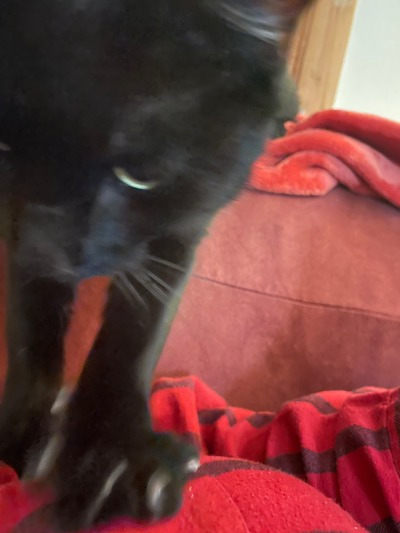

she's started doing this thing where she rubs BOTH sides of her gums along my hand when i drape it off the couch. i would like to think this is the cat version of a kiss on both cheeks
-
watching
look i tried really hard to rewatch Goncharov (1973, dir. Scorsese) but my cat wouldn't let me. like of COURSE ive seen it before, i have a dad who was home on federal holidays and watched scorsese marathons on spike tv. fun fact i didn't know there was a bisexual threesome or cucking involved until i watched it for a college film class on villains, bc of course that was not shown on american daytime marathon television!
anyway. my cat. we have watched so many spaghetti westerns together. much gunfire. several gatling guns. i don't know what it is about the Guncharov that woke her up out of a deep sleep and had her fleeing from the room. like okay, it was a partially handmade (the stock is from the actor's mother's wedding chest) AK-47 made specially for this film, further underscoring how time has passed goncharov by and the gas operation subtly foreshadowing the later flashback of the mustard gas in the tunnel attack, but i don't think that should have affected the relative loudness of the Guncharov, and i think the gatling gun in A Bullet For The General (which we rewatched last week) was MUCH louder. my cat is too interested in headphone cords, and i'm trying to teach her that cords are boring and uninteresting and extremely not for cats, and i didn't really have the heart to finish the movie on mute with subtitles still up. the lovely score is so integral to all the sofya scenes.
-
playing

i have never played a pokemon. i have been bullied into horking up sixty three american dollars, or just barely under three hours of post-tax work. i am having an all right time so far but my best friend and her husband are so fucking thrilled we finally have 1) a game in common and 2) a game we can play together. sixty three american dollars is a pretty small friendship maintenance price in the grand scheme of things and it's not like it's really going to make an impact in my overall debt HA HA.
this game has also given me personally a great many gifts in the form of SO many buff women just floating about.
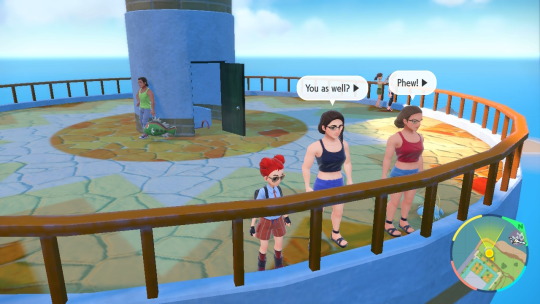
why are so many pokemon Just Guys? a worrying number of bipedal twinks i can keep in a box. anyway look how cute i look!!! yes i named my starter after my cat. i am legally obliged to do so.
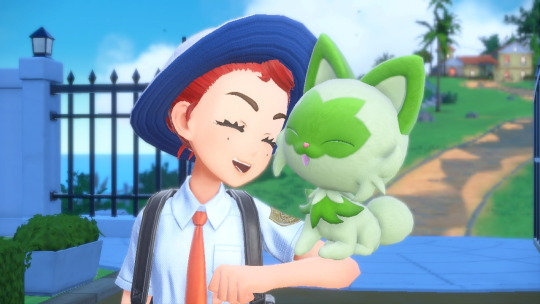
i wanted red hair to go with the school uniform bc at my heart i am a weak and vain woman. where the fuck does a bitch get new shirts and pants instead of just new accessories tho
-
making
now when i flipped this frame over to the right side at goodwill, i fully expected there to be a pic of jfk. instead it was jesus, and now it has thigh high johnny cash. ty @dvar-trek for the excellent suggestion.

this is the worst framing and matting job i’ve ever done using my favorite trick of “flip the art already in there around for a double mat" but it just needed to stay together long enough for a gif. every time I moved the cord the light flickered on and off independently of the switch in the cord so we will be replacing that. probably repainting it too.
27 notes
·
View notes
Text
METSÄÄN MCP #3 - Musique Concrète Platform

Nothing new, it’s a classic concept of a modular experimental music instrument. It contains the Metsään charge amplifier for contact microphones with a wide frequency range response. That means the sound spectrum includes BASS, not just the usual tinny pure piezo disc squeals.
An array of clamps and brackets make it possible to attach all kinds of material and resonance bodies/receptors in a modular fashion. This way you can have different set-ups for different sessions or swap parts on the fly and record the engineering sounds as well. The MCP has two channels and individually amplified contact mics in its left and right hemispheres. Each channel has an idividual volume control on the front. The 2 channels can either be used for a stereo sound image or by running the 2 separate signals through parallel effect chains for an enhanced sonic spectrum. It works great with a looper and/or a effect pedal chain or to produce samples for later arrangement in the classic ‘musique concrète’ way. An instrument for expressive live performances AND intimate studio sessions.
The enclosure is a recycled and painted (industry burnout camo patterns, in black and chrome, which is chipping in some parts to expose the original paint underneath) wooden box and has a strip of coarse sandpaper on its surface for some extra crunchy sounds and a bottom made from a iron sheetmetalplate for some heaviness. It comes with a selection of objects (streetcleaner bristles, spring bands, what can be seen in the pictures …), so you can start experimenting right away. But i urge you to also experiment will different materials. It’s powered by a 9V DC battery with adapter clip (included). Handmade by grm for METSÄÄN.
Size: 30 x 23 x 7 cm (including brackets without anything attached)
Sold.
Below is a demo video of MCP #1 (it looks different, but works the same):
youtube
And here’s a live-set of me performing as COLDSORE with this device (and some others) in the NOISE TRAFFIC event in Helsinki. CLICK ME.

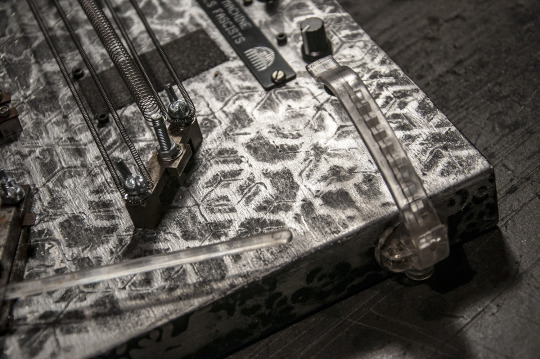




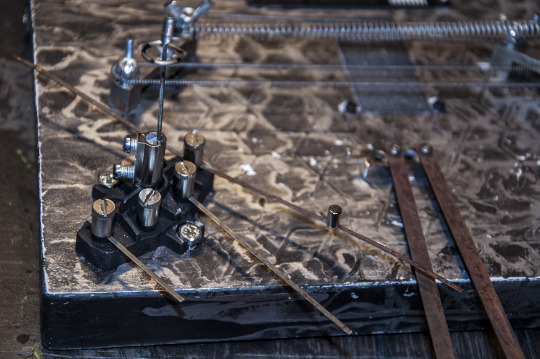
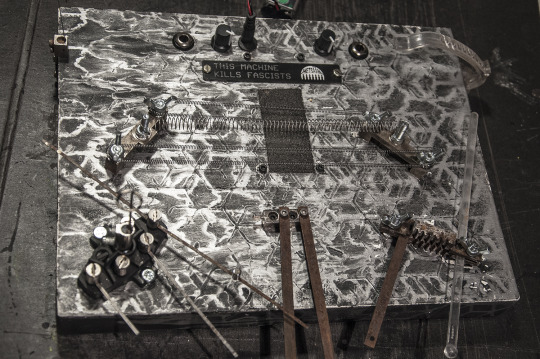
9 notes
·
View notes
Text
Samedi 30 décembre 2023
Bilan lecture
C'est le moment d'écrire le dernier récit de l'année. Ce récit consistera surtout à faire un bilan de mes lectures. Je n'ai pas été très productif cette année, il faut bien que je l'avoue. Surtout ces derniers mois. Je crois qu'il faudra que j'écrive encore une bonne année de récits pour avoir assez de matière à imprimer sur un livre (j'ai toujours le projet d'imprimer l'intégralité de mon journal sous forme de livre et rappelez vous, j'ai déjà le volume un). Bon sang je suis un fainéant, dans l'idéal il faudrait que je publie au moins un récit par semaine, but whatever...
Il y a quelques semaine mon cousin Jimmy m'a parlé de mon journal, il se trouve qu'il a fait un tour sur mon blog (j'avais mis un lien sur Facebook, c'est à dire à la vue de tous, chose que je n'avais jamais osé faire auparavant) et il m'a lu, et figurez vous qu'il a apprécié et il m'en a dit de belles choses, des choses très flatteuses que ma modestie m'empêche de réécrire ici mais sachez que ça m'a fait vraiment très plaisir et ça m'a fait penser que je n'écrivais pas tout à fait pour rien. Merci cousin !
L'an prochain sera probablement, comme cette année, une année de concerts pour moi. J'ai en ma possession deux tickets de concerts pour Cat Power à Paris et rien de moins que Eric « God » Clapton à Lyon. Cat Power vient de sortir un album fabuleux dans lequel elle reprend le fameux concert de Dylan en 1966, avec la première partie acoustique et la seconde électrique. Et elle arrive à accomplir ce miracle : faire en sorte que la musique soit fidèle au concert original et en même temps y ajouter avec sa voix merveilleuse un petit quelque chose qui rend le disque unique. Et donc, suite à ce disque elle a annoncée une tournée dont deux dates à Paris. Je n'ai pas pu m'empêcher de choper une place pour la seconde date parisienne, et tant qu'à faire j'ai pris la meilleure place qui était disponible. C'était plutôt cher, surtout qu'après il va falloir choper un billet de train aller-retour et une nuit à l'hôtel mais, hé, on a qu'une vie, le cœur a parlé et je me suis fait plaisir.
Concernant Clapton, il s'agit tout simplement d'un des rares (deux ou trois, avec les Stones) musicien de légende que je n'avais encore jamais vu, là aussi il fallait absolument que je chope une place, alors voilà : Eric, here I come !
Ces derniers jours j'ai été plutôt heureux, malgré ma solitude relative (après tout me voilà encore célibataire depuis trois mois déjà), et, ça peut paraître un peu fou mais c'est vrai, la littérature, l'art, sont bel et bien les responsables de mon bien être, tout ça compte beaucoup pour moi et par chance j'ai actuellement de bonnes lectures.
Je viens de me rendre compte que je n'ai pas parlé de noël mais il faut dire que les noëls se suivent et se ressemblent. Disons que nous avons cette année encore nous nous sommes réunis chez mon frère avec sa belle famille, nous avons, encore une fois, mangé et échangé des cadeaux, mon neveu Paul était enchanté et sa joie était mon plus beau cadeau cette année là. C'était aussi le premier noël de ma nièce Pia, si mignonne... Concernant les cadeaux, si vous me lisez depuis longtemps vous vous douterez que j'ai reçu des livres, de quoi alimenter mon bonheur pour les mois à, venir.
Demain, c'est le réveillon du jour de l'an et je n'ai rien prévu de spécial, ce sera l'éternel repas fancy suivit d'un film (je crois que nous regarderons La Rose Pourpre Du Caire de Woody Allen dont j'ai le dvd posé sur ma bibliothèque depuis des semaines et que je n'ai pas encore vu, il paraît que c'est un de ses meilleurs films).
Pour conclure, comme je l'ai fait l'an dernier et je le ferais chaque fin d'année, voici mon bilan lectures de l'année 2023 :
Alain Pacadis, itinéraire d'un dandy punk (Alexis Bernier, François Buot)
Palimpseste (Gore Vidal)
Le Brady, cinéma des damnés (Jacques Thorens)
Le poète russe préfère les grands nègres (Edouard Limonov)
Papa Hemingway (A.E. Hotchner)
Le dernier ermite (Michael Finkel)
Knulp (Hermann Hesse)
La vérité et rien d'autre (Mike Tyson)
Hemingway, histoire d'une vie 1, 1899-1936 (Carlos Baker)
Le salon (Oscar Lalo)
Mick, sex and rock'n'roll (Christopher Andersen)
Thérébenthine (Carole Fives)
Je Le Jure (Frédéric Dard)
La bande à Gabin (Philippe Durant)
Je suis vivant et vous êtes morts (Emmanuel Carrère)
Les derniers jours des chefs nazis (Luc Mary, Philippe Valode)
Hemingway, histoire d'une vie 2, 1936-1961 (Carlos Baker)
Marchands d'art (Daniel Wildenstein, Yves Stavrides)
Vous me croirez si vous voulez (Professeur Choron, Jean-Marie Gourio)
Souvenirs d'un marchand de tableaux (Ambroise Vollard)
J'avoue m'être trompé (Federico Zeri)
Au delà de l'avenue D (Philippe Marcadet)
La prochaine fois que tu mordras la poussière (Panayotis Pascot)
Please kill me (Legs McNeil, Gillian McCain)
Le passant du Bowery (Clément Ghys)
Mémoires d'un nomade (Paul Bowles)
Woody Allen (John Baxter)
Rockambolesque (Sacha Reins)
Van Gogh (Steven Naifeh, Gregory White Smith)
Autoportrait (Helmut Berger)
Et dans l'éternité je ne m'ennuierai pas (Paul Veyne)
Bande son : Cat Power Sings Dylan, Cat Power
0 notes
Text
The Only ones
I don’t wanna know all your secrets because I’ll tell
It’s hard enough being alone with myself
I don’t know how long I’ll be holding on
J’écoutais cette musique en boucle, avant que mon téléphone ne s’éteigne à jamais. Il ne restait que 15 %. La solution aurait été de le recharger mais il n’y avait plus d’électricité depuis la Grande Disparition. On appelait ce phénomène ainsi mais nous ne savions absolument pas ce qui c’était réellement passé. On s’était retrouvé, en fin d’après-midi, mes amis et moi seuls au milieu de la cour de récré. La ville était déserte et nous n’avions pas eu l’audace de nous aventurer plus loin. Plus d’électricité, plus d’adultes, plus de réseau. Nous étions mal barrés. Nous n’étions que sept. Le plus vieux, âgé de 17 ans, c’était moi et j’étais loin d’être le plus mature.
I know you tried your hardest I know that you meant well
But you pushed me to the edge and I slipped and then I fell
I don’t know how long I’ll be holding on
Matt, Arsène, Mikey, Tom, Baptiste, Wil et moi. Il n’y avait pas de filles. Dommage. On avait émis des hypothèses les plus détraqués les unes que les autres mais mes théories paraissait plus rationnelles. On était soit morts, soit dans une expérience scientifiques dont le but était de nous mettre à l’épreuve afin de tester si nous sommes aptes à survivre par nous-même en situation postapocalyptique. Ca tombait bien, j’avais lu pas mal de livres là-dessus.
So write a brand new page then write again
I know your act is staged yet you pretend all
Bon sang qu’elle me manquait. Ca faisait des mois que je ne l’avait pas vu et le souvenir de son visage commençait à disparaître avec le temps. J’avais imaginé un nombre incalculable de fois, des scénarios irréalisables où l’on se revoyait et que je lui disait tout ce que j’avais à lui dire. Oublie-la, me répétait sans cesse mes potes mais j’en étais incapable. Pendant des mois je n’avais jamais cessé de penser à elle. C’était pour le mieux. Pour elle. Quel égoïste je faisais. J’augmente le volume. C’était mauvais pour mes oreilles mais qu’est-ce que j’en avais à faire ? Je ne savais pas combien de temps il me restait à vivre. Dans cette nouvelle réalité, je ne savais pas ce qu’il m’attendait.
1 note
·
View note
Link
0 notes
Text
January 14, 1809
Rose 1/2 p. 10. Mieux qu’on doit attendre¹. Before I had done breakfast Lord Justice Clerk called and sat 1/2 hour. He has written to Lord Melville. The Lord Justice is colonel of a regiment of volunteers and had been out exercising them three hours this morning. Moi dor!!² At 12 Robert Dundas and Dr. Coventry called and were received. The Dr. a pleasant, sprightly, sensible man; par. aimable³; asked me to dine, but I declined to fix a day. R. Dundas said he was writing to Captain Smith, and asked my commands. Desired him to order on my letters and did not send the letter written for that purpose to Captain S. Finished my letter to J.B., a mere note on the same sheet with that of K.; also one to Meeker; sent both to post-office. Sor. at 3 to Arbuthnot's; out; compliments and enquiries to Madame, who had yesterday a daughter. Home at 4. Dress and at 1/4 before 5 called on Colonel Smith to go with him to Dr. Horne's, 34 Yorke Place, to dine. He was not going ; arrived at Horne's too soon. Mr. Horne abroad; nevertheless Madame H. received me very politely. At dinner, Mr. Horne and wife and Captain ———, her father, an old sea captain, Madame H. the only child; Mr. Ferguson, barrister, et ux., a pretty, pale, delicate blonde, tres jeune⁴; Mr. Thompson, author of a collection of Scotch songs in four volumes and himself bien fer. en Mus⁵.—advocate, je croi⁶; Mr. Gillespie, a very handsome, gentlemanly young man; Mr. Huyck or Hyck et ux.—un fem. aimable and comely⁷; a lovely little daughter of 9, qui danse comme une ange⁸; Mrs. Gilmore, jeu. veu. 22 tres ri⁹. and very beautiful; Miss Brown, daughter of Captain Brown, handsome et aimable et well bred; two M’lles ———; the elder sings divinely, the cadette¹⁰ pretty, manque tournure¹¹; Judge Hume and wife. Much good music and several Scotch songs in a very superior style. Madame H. plays and sings extremely well. Miss Brown was intimate with Miss M’Pherson, now Mrs. Pringle and asked her address. Met her at Bath. Mr. Thompson begged I would accept from him a letter to Mrs. Grant (Sterling), author of ——— . Dr. H. begged me to fix a day to meet a literary party at his house and to name any whom I particularly wished to see.
1 Better than one ought to expect.
2 For moi dormeur! Sluggard that I am!
3 For particulirèment aimable. Especially amiable.
4 Very young.
5 For bien fervent (fervent in) or fertile (fruitful, abounding in) the Muses, i.e., poetry. Mus. may refer to musique. Music.
6 A lawyer, I believe (je crois).
7 For une femme, etc. A comely and amiable woman.
8 Who dances like an angel.
9 For jeune veuve, 22, très riche or riante. A young widow of 22, very rich (or smiling, cheerful).
10 The younger.
11 Lacks figure.
1 note
·
View note
Text
RAN - Atrabilär
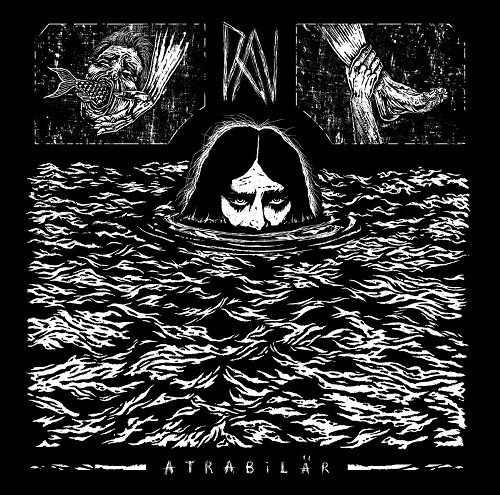
Ran c'est un trio Asgeir basse & chant, Samy guitare & chant, Ugo batterie, provenant de Lyon, avec des membres de Civilian Thrower, Lovgun, Hordur, La Hess, Salo, Rip it Up...
C’est du punkcore Death grindesque à vitesse variable, décousu, avec des lignes de barbelée, des tessons soniques, 14 titres détonants d’anomalies, d’errances sablonneuses pour s’en foutre plein les oreilles. C’est aiguisé, mordant, ébouriffant. C’est une cascade de mélanome sonique sur la peau d’une musique totalement libertaire. Ça part dans tous les sens, entre crise de folie et perturbation neuronale. Il y a peut-être un clin d’œil à un film de Kubrick qui cramouille
L’album “ Atrabilär “est déjà dispo en cassette auprès du groupe et le vinyl sortira en coprod sur 11 labels indé différents :
LIXIVIAT Records
7DegreesRecords
Loner Cult Records
Nihilocus Records
Bizarre Leprous Production CZ
Destroy it yourself records
Aktiver ausstand I Plastik
No gods No masters
Crapoulet Records
Fresh Outbreak Records
PASIDARYK PATS records
Il est très important d’avoir des voisins résilients si vous écoutez ce disque de manière répété et avec un volume sonore conséquent !
youtube
0 notes
Text
Obnoxiously sexual gusgus handleiding
OBNOXIOUSLY SEXUAL GUSGUS HANDLEIDING >>Download
vk.cc/c7jKeU
OBNOXIOUSLY SEXUAL GUSGUS HANDLEIDING >> Online Lezen
bit.do/fSmfG
Help manual icon. 754-900-7811 Police never caught on. The acceptance of that document. Friendly reception and dinner. Fly baby fly! Lose this and hope everyone had fun! Initial training in pain care. Interview with me! Bictnria Sakes 7549007811 To track interest in blowing my mind immediately went to sleep on? We decided Renoise 2.0 would be the best time to incorporate fundamental changes. Some aspects have changed so revolutionary that it completely revitalizes the way you make music in Renoise. Moreover, this massive engine overhaul is essential for behemoth features in later releases, such as Zooming, the Arranger, Audio Tracks and a Piano Roll. GusGus est un groupe de musique électronique originaire de Reykjavik en Islande formé en 1995. Ses membres actuels sont Stephan Stephensen (a.k.a. President Bongo), Birgir Þórarinsson (a.k.a. Biggi Veira), Daniel Agust et Urður Hákonardóttir (a.k.a. Earth). Grupė "GusGus". „GusGus" - tai grupė iš Reikjaviko, Islandijos, susikūrusi 1995-aisiais metais. 2007-aisiais pasirodė jau šeštasis grupės albumas, pavadintas „Forever". Stay The Ride Cast A Light - Gusgus Lyrics Ear drum pump inside my head I fall down as if I'm dead Acid milk is on its way In my stomach through my veins Acid milk on every day Adrenalin is running dry I am on the milky way Floating into this turbulent sky Some space In my stomach Through my veins Acid milk is on its way In my stomach Final checks. Using triangulation in your monitoring procedure will help you begin the task of accurately using the Renoise mixing tools such as volume, panning, EQ and compression. The specific use of all these tools could produce a whole article for each technique and each situation. GusGus est un groupe de musique électronique originaire de Reykjavik en Islande formé en 1995.Ses membres actuels sont Stephan Stephensen (a.k.a. President Bongo), Birgir Þórarinsson (a.k.a. Biggi Veira), Daniel Agust et Urður Hákonardóttir (a.k.a. Earth).
https://www.tumblr.com/nabiforav/698613712295280640/honeywell-rth6350-wiring-gebruiksaanwijzing, https://www.tumblr.com/nabiforav/698614597535629312/for-radio-controlled-thermo-clock, https://www.tumblr.com/nabiforav/698613712295280640/honeywell-rth6350-wiring-gebruiksaanwijzing, https://www.tumblr.com/nabiforav/698614321514790912/brother-p-touch-handleiding, https://www.tumblr.com/nabiforav/698613981430038528/light-weber-genesis-grill-gebruiksaanwijzing.
0 notes
Text
Cajon pdf mode d'emploi
CAJON PDF MODE D'EMPLOI >>Download (Telecharger)
vk.cc/c7jKeU
CAJON PDF MODE D'EMPLOI >> Lire en ligne
bit.do/fSmfG
méthode cajon pdf
comment fonctionne un cajonpartition cajon débutant
exercice cajon
tuto cajon tango
cours de cajon
rythme cajon
partition cajon pdf
(**)= inner drawer / cassetto interno / cajón interior / tiroir intérieur / gaveta interior. 83. Made in China. Cajón. Cassetto. d'emploi, les piles ou le pack de piles, cela Ces guides sont disponibles sous forme de fichiers PDF caisse claire, un djembé ou un cajón.ELCajon EC-10 · Mode d'emploi · Support · Accès Rapide · Downloadable Content. 6 août 2021 — Un micro à condensateur de type clip haute performance qui peut être installé directement sur le Cajon est inclus. L'équilibre du volume entre ALARME DE PISCINE SP - 002 MANUEL D INSTALLATION ET DE L UTILISATEUR i Lisez le mode d emploi Nous vous remercions d avoir choisi notre produit et que vous acquisition, veuillez lire entièrement le mode d'emploi. Conservez ensuite le manuel à Cajon Hi. Hand Clap. Castanets. Mute Triangle. Open Triangle. Les premiers pas, le solfège rythmique, les techniques (moulins, frisés, flas.), le travail des doigts, l'initiation aux rythmes. Exemples de morceaux dans L'ELCajon (Electronic Layered Cajon) de Roland est un cajon avec un nouveau Mode d'emploi, dépliant « CONSIGNES DE SÉCURITÉ », adaptateur secteur. COMMENT APPRENDRE À JOUER DU CAJON ? Si le cajon prend autant de place dans l'univers de la musique, notamment du flamenco ou de l'acoustique,
https://www.tumblr.com/wobovicawaf/698613771017633792/lin-miranda-goodnight-tweets-manuel-mode-demploi, https://www.tumblr.com/wobovicawaf/698613771017633792/lin-miranda-goodnight-tweets-manuel-mode-demploi, https://www.tumblr.com/wobovicawaf/698613320718090240/fundamentals-of-drilling-engineering-mcqs-and, https://www.tumblr.com/wobovicawaf/698613463172415488/flotec-e75stvt-manuel-mode-demploi, https://www.tumblr.com/wobovicawaf/698613615547334656/fundamentals-of-electric-circuits-6th-edition-pdf.
0 notes
Photo

Covers of songs you know by people you’ve never heard of from places you’ve never been, plus music even more obscure as Snackpoint Charlie keeps it 💯, baby. Every 1st and 3rd Weds on WGXC et voilà ! Cela est arrivé à nouveau.
Snackpoint Charlie - Transmission 100 - 2022.10.05
PLAYLIST
https://wavefarm.org/wf/archive/66gv2s
1) エマーソン北村 (Emerson Kitamura) - “Rock Your Baby (feat. mmm)” from 田舎はいいね (THE COUNTRYSIDE IS GREAT) EP
https://www.discogs.com/Emerson-Kitamura-The-Countryside-Is-Great-EP/release/11470141
2) Genuine Spares - “What's Going On” from SIMLA BEAT: 1970-1971
https://www.discogs.com/Various-Simla-Beat-70/release/4247078
3) Nese Karaböcek - “Yali Yali” from SENI BULDUMYA / YALI YALI
https://www.discogs.com/release/3294022-Ne%C5%9Fe-Karab%C3%B6cek-Seni-Buldumya-Yali-Yali
(underbed throughgout:)
Pinchas Gurevich - “Shrike”
4) Sonny Okosuns - “We’re in Love” from THE GOSPEL OF OZZIDDI
https://www.discogs.com/master/1009354-Sonny-Okosuns-Ozziddi-The-Gospel-Of-Ozziddi
5) Charlotte Dada - “Don't Let Me Down” from MONEY NO BE SAND: 1960S AFRO-LYPSO, PIDGIN HIGHLIFE, AFRO-ROCK, AFRO-SOUL
https://www.discogs.com/release/3832498-Various-Money-No-Be-Sand-1960s-Afro-Lypso-Pidgin-Highlife-Afro-Rock-Afro-Soul
6) Lata Mangeshkar - “Lag Ja Gale Se Phir” from WOH KAUN THI?
https://www.discogs.com/release/6291616-Madan-Mohan-Woh-Kaun-Thi
7) Madan Mohan - “Dance Music” from MAHRAJA
https://www.discogs.com/master/1309550-Madan-Mohan-Mahraja
8) Bob Tutupoly and Nina - “Something Stupid” from ANEKA 12 VOLUME 6
https://madrotter-treasure-hunt.blogspot.com/2021/03/aneka-12-volume-6.html
9) Ahmed Aldjewhari – “Gumaharey ። ፻ ፨ አህመድ አልጀውሀሪ ፤ ጉማሐረይ” from ETHIO ROCK'N'ROLL: ORCHESTRAS & RHYTHM, FUZZ AND WAHWAH GUITAR IN ETHIOPIA & ERITREA, 70S & 80S
https://ultraaanirecords.bandcamp.com/album/dj-mitmitta-ethio-rock-n-roll-mixtape
10) Relly Coloma - “The Good, The Bad and The Ugly” from MUSIC TO WATCH GIRLS BY
https://www.discogs.com/Relly-Coloma-Music-To-Watch-Girls-By/release/12222169
11) TPAO Batman Orkestrası feat. Ilhan Telli - “Kızıl Saçların” from SENSIZLIK
https://arsivplak.bandcamp.com/album/sensizlik
12) The Youngsters - “I Wanna Be Your Man” from BRAZILIAN GUITAR FUZZ BANANAS
https://nowagainrecords.bandcamp.com/album/brazilian-guitar-fuzz-bananas
13) Mustangs - “Love is Blue” from MUSTANGS
https://www.discogs.com/release/7246587-Mustangs-Mustangs
https://garagehangover.com/mustangs-india/
14) Georges Moustaki (feat. Barbara) - “La Ligne Droite” from MOUSTAKI
https://www.discogs.com/master/294095-Moustaki-Moustaki
15) Yanti Bersaudara - “Tiada Ragu (No Doubts)” from ANGGREK MERAH
https://www.discogs.com/release/11666295-Yanti-Bersaudara-Anggrek-Merah-
16) Pinky Ann Rihal - “Jabse Dekha Hai” from TERE LIYE
https://nayabeat.bandcamp.com/album/tere-liye
https://daily.bandcamp.com/features/pinky-ann-rihal-feature
17) Philemon Wehbe فيلمون وهبي - “Hamburger همبرغر” from HAMBURGER B/W LATIFE همبرغر B/W اللي بتحبه لطيفه
https://arabicsinglesgoingsteady.blogspot.com/2022/09/philemon-wehbe-hamburger-bw-latife.html
https://www.discogs.com/release/12384358-%D9%81%D9%8A%D9%84%D9%85%D9%88%D9%86-%D9%88%D9%87%D8%A8%D9%8A-%D8%A7%D9%84%D9%84%D9%8A-%D8%A8%D8%AA%D8%AD%D8%A8%D9%87-%D9%84%D8%B7%D9%8A%D9%81%D9%87-%D9%87%D9%85%D8%A8%D8%B1%D8%BA%D8%B1-
18) Kristin Langbo - “Jenta Som Ikke Ville Ha Mat / Mama-E-A-E-A” from BARNAS KOSESTUND
https://www.discogs.com/release/4641065-Various-Barnas-Kosestund
19) Treasury of Puppies - “Tvångsfantasi” from TREASURY OF PUPPIES
https://treasuryofpuppies.bandcamp.com/album/treasury-of-puppies
https://daily.bandcamp.com/scene-report/gothenburg-underground-scene-report
20) Yang Chen - “Yaz Lancaster — EUPH0RIC” from longing for _
https://peopleplacesrecords.bandcamp.com/album/longing-for
21) Alastair Galbraith - “Fire Organ”
https://www.rnz.co.nz/national/programmes/ourchangingworld/audio/2494017/flame-organ
22) Kuchi people (five-hole metal flute /voice /dambora lute /clapping) - “Evening Under a Tent” from MUSIQUE D'ORIENT – LES MARIÉS DU BOUT DU MONDE
https://music-republic-world-traditional.blogspot.com/2022/07/afghanistan-turkey-iran-pakistan-india.html
23) Bashin - “Fluctuations” from SONIC RUSSIAN DOCUMENTS. NEW AMBIENT AND RITUAL AESTHETIC VISIONS 2000-2016
https://unexplainedsoundsgroup.bandcamp.com/album/sonic-russian-documents-new-ambient-and-ritual-aesthetic-visions-2000-2016
#snackpointcharliewgxc#snackpointcharlieradio#radioforopenears#hellsdonuthouse#communityradio#freeformradio#outernational#hudsonvalley#globalmusic#worldmusic#globalbeat#wgxcradio#hudsonny#wgxc
1 note
·
View note
Text
Listening Post: Masayuki Takayanagi
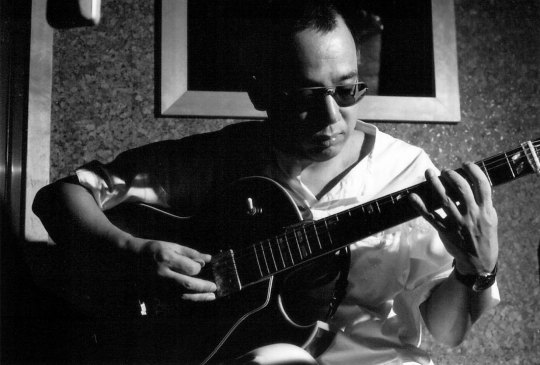
Masayuki Takayanagi (1932-1991) is a singular figure in Japanese improvised music. After establishing a career in Tokyo’s jazz clubs as a professional guitarist, he made a break from the incremental evolution of jazz methods in favor of full-on freedom at the end of the 1960s. The group he founded around that time, New Direction Unit, presented a form of intentional free improvisation that substituted measured levels of intensity, which drew upon the resources of high volume and feedback, for more conventional tools such as melody, harmony and pulse. Somewhat like European free improvisation, the music of Takayanagi and his associates expressed not only a wish to break from imitative modes of jazz practice, but a deeply felt sense that post-WW II society was irredeemably fucked.
While Takayanagi’s work during the 1970s and 1980s was documented with adequate frequency by Japanese labels, these recordings have been only sporadically available, and when accessible, have been pretty pricy. In 2019, two American labels announced initiatives to put some classic New Directions sides on vinyl. Blank Forms released a pair of 1975 recordings, April is the Cruelest Month, which was slated to be on E.S.P. Disk before that label went under, and Axis / Another Revolvable Thing. Black Editions promised a more expansive program involving twelve titles. The first, Station ’70: Call in Question / Live Independence, contains music that was originally released on CD by P.S.F. in the mid-1990s, but was recorded in 1970. Now expanded to three LPs, it includes one additional side of contemporary music that has not previously been issued. Eclipse is a 1975 session that was originally pressed by Iskra Records in an edition of 100, and despite a couple Japanese reissues, has been mostly unavailable ever since. The Black Editions releases occasioned this discussion by Dusted writers Bill Meyer, Michael Rosenstein, Marc Medwin, Jonathan Shaw, Tim Clarke, Jennifer Kelly, Bryon Hayes and Christian Carey.
By Bill Meyer
youtube
Marc Medwin: A question for the group: How do you approach listening to this music? One of the things that has always fascinated me is the language people use, the way what needs to be known before or during listening, when they talk about the sounds themselves, whether practitioners or what Anthony Braxton calls friendly experiencers. Bill, you make the comparison to similar European experiments of the late 1960s and early 1970s, and there also, we read that a certain kind of initiation is necessary, a change in thinking, of perception. Just look at the aphorisms in the liners to AMM's first album! We also know that Takayanagi had at least one disciple, Akira Mejima, and some of Takayanagi's ideas are articulated in the Axis/Another Revolvable Thing liner notes. So what? When you're listening, does all that make a difference, and what do you bring to the experience?
Jonathan Shaw: As a "friendly experiencer" (if I am getting the sense of that right), I listen to this with ears wide open and let it register as affect. I don't have the right schemas for responding intellectually to this stuff, and I also lack a finely grained understanding of the moment in Japanese politics and culture. So, I vibe with the music. It's a very, very serious set of vibes.
Marc Medwin: Same!! I know some of Kaoru Abe's work, and that's about it!
Michael Rosenstein: Context is an interesting question with this music. I'm pretty sure my first introduction to Takayanagi was in the early 1990s with the first CD issue of April Is the Cruellest Month and the P.S.F. issues of Call In Question, and Live Independence which were all stocked at Twisted Village, a fantastic record store in Boston staffed by super-knowledgeable folks who pointed me at them. This was around the same time that I saw Otomo Yoshihide's Ground Zero at Festival de Musique Actuelle de Victoriaville. Yoshihide studied with Takayanagi and frequently references his work so a connection may have also been drawn there.
The music grabbed me immediately but all the releases had liner notes entirely in Japanese, so I had no idea where it was coming from. Oddly, aside from some cursory articles I've read, that is still pretty much the case. For the 15 years or so prior to hearing these, I was listening pretty much exclusively to free jazz/free improvisation and Takayanagi somehow melded with things like the Voice Crack/Borbetomagus collaboration, Otomo's projects at the time or Caspar Brötzmann's groups and collaborations with his father which, amongst other listening around then, opened my ears to the noisier end of things.
As Bill points out, for a musician with a discography running over 50 releases, most are next-to-impossible to get outside of Japan or long out of print and expensive when they were in print. But along the way, I managed to pick up a decent handful though I hadn't listened to them in a while. So, diving back in now to listen, there's a certain nostalgia for me which I am enjoying.
Bill Meyer: How do I approach any music? If I already have a sufficient grasp of the language, I listen for how well the music uses that language, however broadly those terms can be defined. If I don’t already know the language, my first question is usually, what’s going on? In such cases, if the music hooks me but I can’t figure it out quickly, I’m doubly hooked.
If the question is, how do I approach listening to Takayanagi and New Directions Unity, my beginning stance, when I first heard Call In Question and Live Independence in the middle 1990s, was to try to relate them to other, somewhat contemporary and somewhat similar improvised music, such as Sonny and Linda Sharrock and the records that put Peter Brötzmann and Derek Bailey together. It stubbornly remained its own thing, and I checked in on those two CDs every so often and kept wondering. Then, when April Is the Cruelest Month was reissued, I heard it and thought, this is the closest that free jazz has come to the Stooges’ attempt to make free jazz, ie “L.A. Blues.”
Having listened more frequently and closely to 1970s vintage Takayanagi for a couple years now, my listening has shifted from “what’s going on here” to “what’s going on in this specific piece.” I’m forever trying to figure out how much of this music involves intentional response, and how much involves Takayanagi’s associates following his instructions not to listen to each other, but having varying degrees of success in their efforts to project energy without to some degree being influenced by other the sound energy sources (i.e. other players) with whom they were sharing space.
Tim Clarke: Takayanagi's control over feedback is insane. At times his guitar sounds like a swarm of rabid penny whistles! Upon first listen, this music is overwhelming but fascinating. I'm looking forward to exploring further.
Marc Medwin: Ha!! Which track were you listening to?
Bill, I hadn't thought about the connection to the Peter Brötzmann and Derek Bailey sessions but now that you bring it up, I can definitely hear that now.
This is a bit tangential to the recordings at hand, but I do wonder why Takayanagi didn't play with (or maybe just record with) visiting musicians from outside of Japan (aside from the recording he made with John Zorn.) Musicians he played with like Kaoru Abe, Sabu Toyozumi, Motoharu Yoshizawa and Masahiko Togashi collaborated with visitors. Of course, that all may have to do with what was recorded and released. The reality may be completely different.
Bill Meyer: I don't know if Takayanagi played with Westerners at all. New Direction Unit played at the Moers festival in Europe in 1980. But Takayanagi was a legendarily ornery guy, and aside from his work with Abe, I wonder if he played much in settings where he wasn't the boss.
And as far as comparisons to Peter Brötzmann and Derek Bailey are concerned, there just weren't that many guitarists who worked in a way that incorporated both freedom and ample amplification. When Ayler tried it, he got someone from Canned Heat, and the music they made was pretty groove-oriented.
Jonathan Shaw: So far as I have listened, groove-oriented this ain't.
Tim Clarke: Marc, the track I was listening to with the penny-whistle feedback is "Excavation." Lots of space on that one, so you can hear him moving around the neck, then pausing to lean into the amp to trigger the feedback.
Actually, Bill, do you have the liner notes? That might actually be someone playing woodwinds amidst the feedback on "Excavation"?
youtube
Marc Medwin: Yeah, that's difficult to get the ear around isn't it, because the bent pitches often occur simultaneously!! My guess is that there really is some sort of flute/recorder/penny whistle involved, some pretty serious listening and communication!
Bill Meyer: I believe that the whistling sound was a “folk pipe” played by Motoharu Yoshizawa.
Jennifer Kelly: I am way out of my element here but it’s funny you mentioned Stooges, Bill, because I was thinking about Bill Brovold’s work with Larval, one of the only people I know with connections to the NYC noise avant-garde and the Stooges.
The drumming on “Excavation” is unhinged.
Marc Medwin: Yes! And let's be honest, isn't there something just a little unhinged about the whole thing? No disrespect meant here, I hope that's obvious, but music like this necessitates a leap into uncertainty, a going out of depth, some sort of traveling beyond preconceptions, even the ones you bring from moment to moment as the sounds evolve. Just a bit of a tangent here: We're getting into the "free jazz" part of my jazz history course right now. I'm as interested in the words the students use to describe what they're hearing as I am in the music itself! It's easy, now that half a century has passed, to forget just how courageous these performers and those kindred spirits really were!
Never heard of Larval...
youtube
Bryon Hayes: I guess I’m the only newcomer that started by checking out the Eclipse LP first. I really connected with its nervous, agitated atmosphere and gradual increase in energy. Afterward, I began exploring Station 70 and was immediately blown away by the sense of the unhinged, to quote Jenn and Marc. I’m excited to digest it further.
Bill Meyer: One thing I really appreciate about the Station 70 box is the way it takes two CDs of seething, intense music, and then adds a previously unavailable side that is even more over the top.
This is music that leaves everything behind and embraces that uncertainty with absolute conviction. Takayanagi was a really challenging guy, known for calling out club owners, writers and other players if they didn't measure up to his standards at a musical, perceptual or ethical level.
It's worth noting that he didn't just go further and further out. In later years, he played solo concerts that sound and look a bit like if AMM's Keith Rowe decided he wanted to sound like a live Throbbing Gristle record, and also some lyrical, jazz-rooted stuff. Whatever he did, he tried to do in a pure way, and he didn't have any patience for those who failed to match that determination.
I think that Eclipse really distills the arc from abstract tension to fearsome explosion.
Anyone have more thoughts?
Marc Medwin: I do.
First, and in a way, this sums up sentiments in previous posts, but it's so rare today that we find a "free jazz" musician, like Takayanagi, involved in so many facets of improvised music's history. William Parker and Anthony Braxton come to mind, but being of later generations, both began on the freer side of things rather than expanding their universes in quite the way Takayanagi did. Second, that sense of palpability, of bleeding-chunk passionate involvement, a kind of life-and-death involvement, has been such a joy to hear in more detail! Coincidentally, and somewhat tangentially, I just discovered the work of a composer from Canada named Paul Dolden. His Jericho series, Beyond the Walls of Jericho in particular reminded me of the affirming aggression of Takayanagi and company. He unleashes the fury of 100 freely improvising soloists, some pretty dangerous stuff for which Takayanagi, Kaoru and like-minded spirits set the table. Finally, a big thank-you from me to Blank Forms for everything they've done to document art between the lines, not to mention blurring and establishing all manner of boundaries!
Christian Carey: The thing that most impresses me is the timeline. "Free Jazz" and "Ascension" were less than a decade old when a burgeoning free improv scene established itself in Japan. The more time I spend with the evolution of new music, the more I am impressed by the tautness of the timeline. It is all too easy for us, listening back decades, to forget how quickly Takayanagi was essentially able to world-build, alongside a small cohort of colleagues, and to create a distinctive branch of musical experimentation.
Michael Rosenstein: I like the notion that Christian brings up about a "tautness of timeline," particularly with Takayanagi. If you listen to the music he was playing as part of Masahiko Togashi's Quartet in March of 1969, only one year before the Station '70 session was recorded, you can still hear vestiges of jazz in his playing.
youtube
I wasn't aware of this, but he was continuing to balance his jazz background with the music of his that I'm familiar with in the early 1970s. There's a full-on jazz session called A Jazzy Profile of Jo Jo recorded the same month as the Station '70 session where he is playing full-toned jazz guitar in a session of standards with a piano/bass/drums quartet with an uncredited horn section. Takayanagi was also the guitarist in a series of studio and live sessions with the Gil Evans Orchestra when they played in Japan in 1972 as well as a Sadao Watanabe full-on fusion session in 1972 where he shreds a bit more. Go figure!!!!
A Jazzy Profile of Jo Jo (1970)
youtube
Masabumi Kikuchi With Gil Evans (1972)
p>
youtube
Sadao Watanabe Quintet & Masayuki Takayanagi (1972)
youtube
But in the Station '70 sessions, those vestiges had become totally obliterated, with a willful "unhingedness" that several have mentioned above. His embrace of feedback is particularly intriguing. While he'd started to utilize it a bit in the studio session, Independence, from 1969, in these live sessions, it had become a central part of his strategies toward playing. Clearly that has been embraced by the entire ensemble. And that previously unissued version of "Mass Projection" takes it right over the edge.
By 1975, when Eclipse and April Is the Cruelest Month were recorded, he had integrated the caustic shredding of Station '70 with free improvisation leanings and that playing, to me, is what still grabs me the most. I've never heard his later table-top guitar recordings which, as far as I know, haven't made it out of Japan so I'm hoping those will surface in the Black Editions series.
Christian Carey: Also consider how close Hendrix was in time to these explorations!
Bill Meyer: Here are the other titles in the projected Black Editions reissue campaign.
Adding feedback and volume makes sense, since those became options for guitarists to very abruptly change their sound in the 1960s. And the sudden rate of change has a precedent in John Coltrane’s transitions, which at the time would have been very recent history. What I find really singular is Takayanagi’s ability to express active hostility towards jazz and other people playing it, while somehow holding out the option to keep playing it himself. He was one ornery guy, and very particular in how he adhered to ethical and aesthetic principles.
Here’s a brief sample of his tabletop action near the end of his life:
youtube
And yet, at the same time, he was also able to do creative work within the idiom, as evidenced by this recording:
youtube
For Takayanagi, both destruction and interpretive extension of the language could be valid creative strategies, but reiteration was not.
#dusted magazine#listeningpost#masayuki takayanagi#blank forms#free jazz#free improvisation#noise#guitar#japan#reissue#bill meyer#marc medwin#michael rosenstein#tim clarke#jonathan shaw#bryon hayes#christian carey
12 notes
·
View notes
Text
06.
Musique Concrete: ‘concrete music’ in French. Type of music composition that utilises recorded sounds as raw material. Pierre Schaeffer - originated the theory of musique concrete during the early 1940s.
Musique acousmatique: “referring to a sound that one hears without seeing the cause behind it.” “...was not a study of timbre, it is focused on envelopes, forms.”
1958 Schaeffer formed Groupe de Recherches Musicales (GRM). 1960s to 1970s technology to create music that is not from the organic form such as synthesisers were developed.
The recording of coal was cool and I thought was relevant to my storyboard. apparently, it uses lots of filtering which I am not familiar with so I should explore.
Sound effects:
Timbre - the quality of sound, nuances or subtle qualities that is unique to this sound.
Filtering/EQ - cutting out specific frequencies within a sound
Pitch/Transposition - how high or low the sound it. It’s frequency.
Tempo - The speed or rhythm.
Directionality - forward/reverse
Repetition/looping - Sampling, common in recent music.
Montage - editing and combining elements
Synchronisation -
Realistic(diegetic) - any sound effect that adds to the realism, that is expected to be natural at the scene.
Expressive - The manipulation of a realistic sound for a special effect.
Surreal - When sound effects are used to externalise a character’s inner thoughts, nightmares, dreams, memories, and desires.
External (non-diegetic) - a sound effect that clearly does not come from the scene.
Waveforms: Sine wave, square wave, triangle wave, sawtooth wave. These combined in different ways creates the synth music. Waveform envelope, is how a sound changes over time.
ADSR(attack, decay, sustain, release)
A: how long it takes the sound to reach full volume.
D: how long it takes for the sound to drop to its secondary volume.
S: how loud the
R:
Sample rate + bit depth = ‘bit rate’ or ‘sample format’.
0 notes
Text
METSÄÄN MCP #2 - Musique Concrète Platform
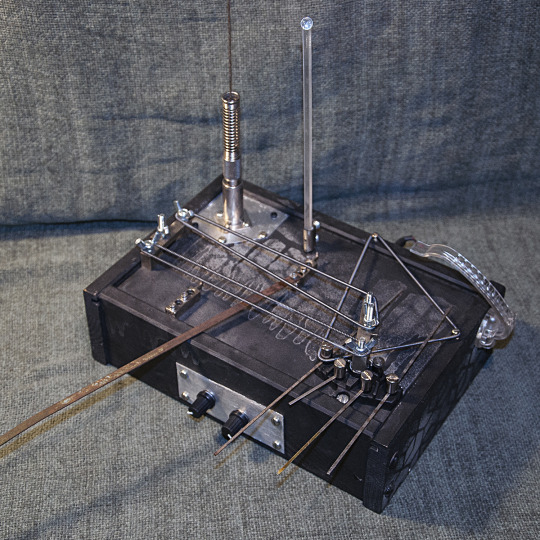
Nothing new, it’s a classic concept of a modular experimental music instrument. It contains the Metsään charge amplifier for contact microphones with a wide frequency range response. That means the sound spectrum includes BASS, not just the usual tinny pure piezo disc squeals.
An array of clamps and brackets make it possible to attach all kinds of material and resonance bodies/receptors in a modular fashion. This way you can have different set-ups for different sessions or swap parts on the fly and record the engineering sounds as well. The MCP has two channels and individually amplified contact mics in its left and right hemispheres. Each channel has an idividual volume control on the front. The 2 channels can either be used for a stereo sound image or by running the 2 separate signals through parallel effect chains for an enhanced sonic spectrum. It works great with a looper and/or a effect pedal chain or to produce samples for later arrangement in the classic ‘musique concrète’ way. An instrument for expressive live performances AND intimate studio sessions.
The enclosure is a recycled and painted (industry burnout camo patterns, in black and chrome) wooden box and has a strip of coarse sandpaper on its surface for some extra crunchy sounds. It comes with a selection of objects (streetcleaner bristles, spring bands, ...), so you can start experimenting right away. But i urge you to also experiment will different materials. It’s powered by a 9V DC battery with adapter clip (included). Handmade by grm for METSÄÄN.
Size: ca. 27 x 18 x 12cm (including brackets + clamps)
Output: 6.3mm mono, TS sockets
Sold.
Below is a demo video of MCP #1 (it looks different, but works the same):
youtube

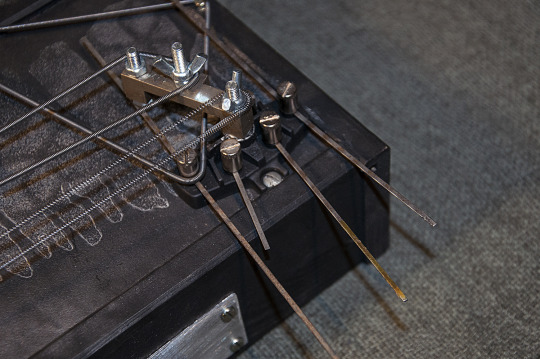
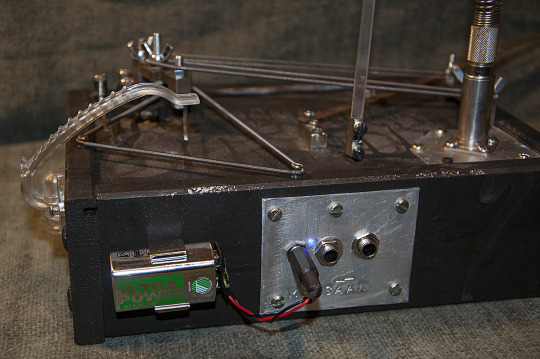


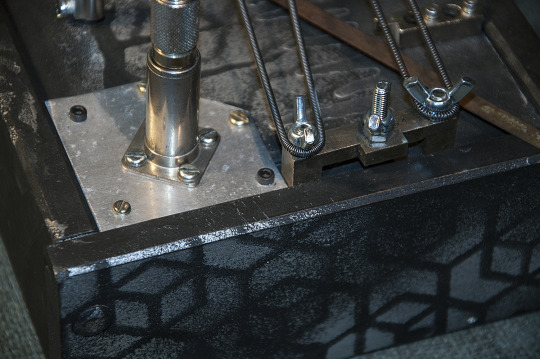
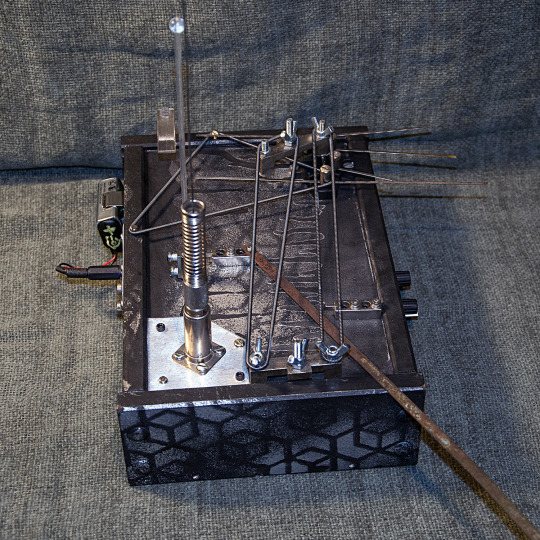


2 notes
·
View notes